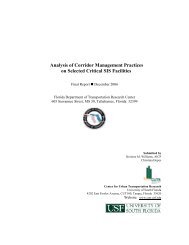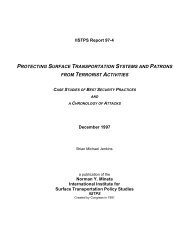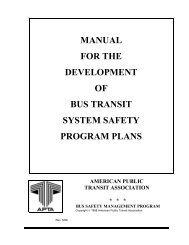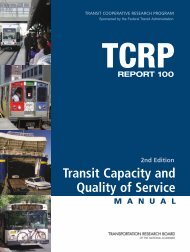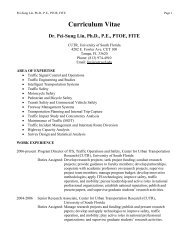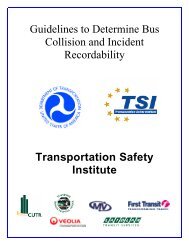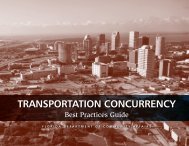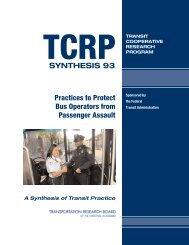a technical guide for conducting pedestrian safety assessments
a technical guide for conducting pedestrian safety assessments
a technical guide for conducting pedestrian safety assessments
You also want an ePaper? Increase the reach of your titles
YUMPU automatically turns print PDFs into web optimized ePapers that Google loves.
UNIVERSITY OF CALIFORNIA BERKELEY • INSTITUTE OF TRANSPORTATION STUDIES • TECHNOLOGY TRANSFER PROGRAM<br />
37<br />
TABLE 7: EXAMPLE PEDESTRIAN IMPROVEMENT MEASURES<br />
Measure Description Benefits Application<br />
Textured<br />
Pavers<br />
Textured pavers come in a variety<br />
of materials (<strong>for</strong> example, concrete,<br />
brick, and stone) and can<br />
be constructed to create a textured<br />
<strong>pedestrian</strong> surface such as<br />
a crosswalk or sidewalk. Crosswalks<br />
are constructed with the<br />
pavers, or can be made of<br />
stamped concrete or asphalt.<br />
Highly visible to motorists,<br />
this measure<br />
provides a visual and<br />
tactile cue to motorists<br />
and delineates a separate<br />
space <strong>for</strong> <strong>pedestrian</strong>s,<br />
as it provides a<br />
different texture to the<br />
street <strong>for</strong> <strong>pedestrian</strong>s<br />
and motorists. It also<br />
aesthetically enhances<br />
the streetscape.<br />
Appropriate <strong>for</strong> areas with high<br />
volumes of <strong>pedestrian</strong> traffic<br />
and roadways with low visibility<br />
and/or narrow travel ways, as in<br />
the downtown area of towns<br />
and small cities.<br />
Anti-Skid<br />
Surfacing<br />
Surface treatment is applied to<br />
streets to improve skid resistance<br />
during wet weather. This is a<br />
supplementary tool that can be<br />
use to reduce skidding in wet<br />
conditions.<br />
Improves driver and<br />
<strong>pedestrian</strong> <strong>safety</strong>.<br />
Appropriate <strong>for</strong> multi-lane roadways<br />
and roadways with higher<br />
posted speed limit and/or high<br />
vehicle volumes or collision<br />
rates.<br />
Accessibility<br />
Upgrades<br />
Treatments such as audible<br />
<strong>pedestrian</strong> signals, accessible<br />
push buttons, and truncated<br />
domes should be installed at<br />
crossings to accommodate disabled<br />
<strong>pedestrian</strong>s.<br />
Improves accessibility<br />
of <strong>pedestrian</strong> facilities<br />
<strong>for</strong> all users.<br />
Accessibility upgrades should<br />
be provided <strong>for</strong> all <strong>pedestrian</strong><br />
facilities following a citywide<br />
ADA Transition Plan.<br />
Pedestrian<br />
Countdown<br />
Signal<br />
Displays a “countdown” of the<br />
number of seconds remaining <strong>for</strong><br />
the <strong>pedestrian</strong> crossing interval.<br />
In some jurisdictions the countdown<br />
includes the walk phase.<br />
In other jurisdictions, the countdown<br />
is only displayed during the<br />
flashing don’t walk phase.<br />
Increases <strong>pedestrian</strong><br />
awareness and allows<br />
them the flexibility to<br />
know when to speed up<br />
if the <strong>pedestrian</strong> phase<br />
is about to expire.<br />
The <strong>for</strong>thcoming 2009 MUTCD<br />
is expected to require all<br />
<strong>pedestrian</strong> signals to incorporated<br />
countdown signals within<br />
ten years. The signals should<br />
be prioritized <strong>for</strong> areas with<br />
<strong>pedestrian</strong> activity, roadways<br />
with high volumes of vehicular<br />
traffic, multi-lane roadways,<br />
and areas with elderly or disabled<br />
persons (who may walk<br />
slower than others may).



